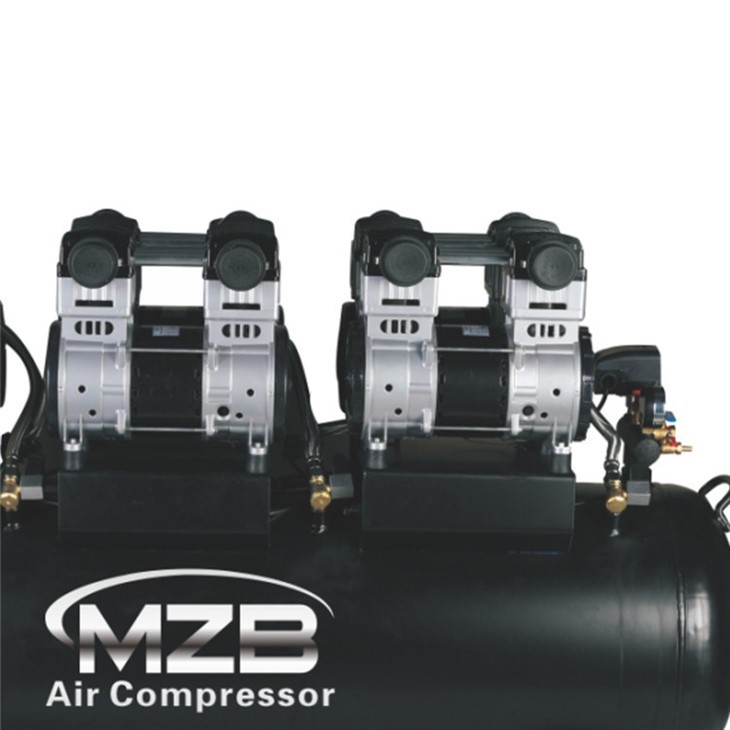Dealing with a noisy oil-free portable air compressor can be a challenge, especially when you're trying to use it in a quiet environment or when the noise starts to become a nuisance. As a supplier of Oil Free Portable Air Compressors, I've encountered numerous customers who've faced this issue. In this blog, I'll share some effective strategies to address the noise problem associated with these compressors.
Understanding the Sources of Noise
Before we dive into the solutions, it's crucial to understand where the noise comes from. Oil-free portable air compressors typically generate noise from several sources. The motor is a significant contributor. As it runs, it produces vibrations and mechanical noise. The compression process itself can also be noisy, especially when the air is rapidly compressed and released. Additionally, the intake and exhaust of air can create a whooshing or whistling sound.
Isolation and Mounting
One of the most effective ways to reduce the noise from an oil-free portable air compressor is through proper isolation and mounting. Placing the compressor on a vibration-dampening mat can significantly reduce the noise transmitted to the floor. These mats are usually made of rubber or other soft materials that absorb the vibrations generated by the compressor. You can also consider using anti-vibration mounts. These mounts are designed to isolate the compressor from its surroundings, preventing the vibrations from spreading and reducing the overall noise level.
Another option is to build a custom enclosure for the compressor. The enclosure can be made of sound-absorbing materials such as acoustic foam or fiberglass. However, when building an enclosure, it's essential to ensure proper ventilation. The compressor generates heat during operation, and without adequate ventilation, it can overheat, leading to potential damage. You can install vents or fans in the enclosure to maintain proper airflow.
Regular Maintenance
Regular maintenance is key to keeping your oil-free portable air compressor running quietly. Over time, parts can wear out, become loose, or accumulate dirt and debris, all of which can increase the noise level. Check the compressor regularly for loose bolts or screws and tighten them as needed. A loose part can cause excessive vibrations, leading to increased noise.
Clean the air intake filter regularly. A clogged filter can restrict the airflow, causing the compressor to work harder and generate more noise. Refer to the manufacturer's instructions for the proper cleaning or replacement interval for the filter. Also, inspect the belts and pulleys (if applicable) for signs of wear and tear. Worn belts can slip, causing a screeching noise, while misaligned pulleys can create additional vibrations.
Upgrading to a Quieter Model
If you've tried all the above methods and the noise is still a significant issue, it might be worth considering upgrading to a quieter model. At our company, we offer a range of quiet oil-free portable air compressors. For example, our Super Silent Air Compressor is specifically designed to operate with minimal noise. It features advanced noise reduction technology and high-quality components that ensure a smooth and quiet operation.
Another option is our Quiet Dental Air Compressor. This compressor is ideal for dental clinics and other environments where noise reduction is crucial. It offers a balance between performance and quiet operation, making it a popular choice among our customers.
If you need a high-pressure compressor with low noise, our 8 Bar High Pressure Oil Free Air Compressor is a great option. It combines high-pressure performance with quiet operation, making it suitable for a variety of applications.
Using Noise-Canceling Technology
In some cases, you can use noise-canceling technology to reduce the perceived noise level. Noise-canceling headphones or earplugs can be worn by the operator to block out the noise. These devices work by generating sound waves that are the exact opposite of the incoming noise waves, effectively canceling them out. While this doesn't reduce the actual noise produced by the compressor, it can make the working environment more comfortable for the operator.
Strategic Placement
The placement of the compressor can also have a significant impact on the noise level. Try to place the compressor in a location where the noise will be less of a problem. For example, if you're using the compressor in a workshop, place it in a corner or against a wall. This can help to absorb some of the sound waves and reduce the overall noise level in the room. You can also place the compressor in a separate room or enclosure if possible. This will further isolate the noise and prevent it from spreading to other areas.
Conclusion
Dealing with a noisy oil-free portable air compressor doesn't have to be a headache. By understanding the sources of noise and implementing the strategies mentioned above, you can significantly reduce the noise level and make your compressor more comfortable to use. Whether it's through proper isolation and mounting, regular maintenance, upgrading to a quieter model, or using noise-canceling technology, there are several options available to address the noise issue.
If you're in the market for a new oil-free portable air compressor or need help with reducing the noise of your existing compressor, we're here to assist you. Our team of experts can provide you with more information about our products and offer personalized solutions based on your specific needs. Contact us today to start the conversation and explore how we can help you find the perfect compressor for your requirements.


References
- Manufacturer's manuals for oil-free portable air compressors
- Industry standards and guidelines for noise reduction in air compressors
- Research papers on vibration and noise control in mechanical systems





